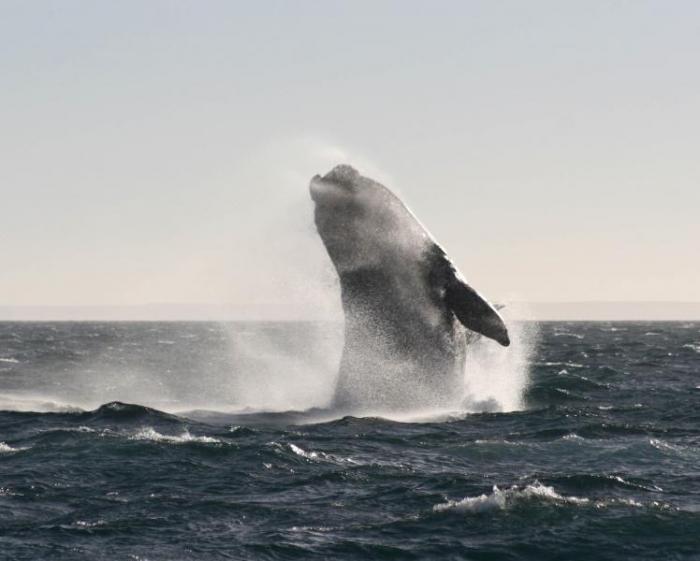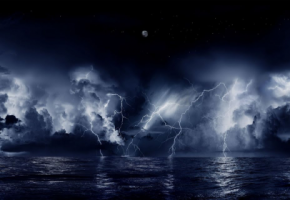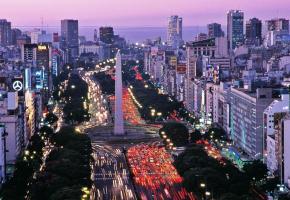The whale-watching season officially kicks off in Mayin Puerto Pirámides, a village located 100km north of Puerto Madryn in the province of Chubut, to great excitement on a local and international scale. Millions of Argentine TV viewers catch the first glimpses of the southern right whales while more than 400,000 watch every slow-moving duck and dive via the internet. Every year, the southern rights, of which 1,000 of the estimated 10,000 in existence have been identified, make their way to the region in pods of two or three.
The tiny Patagonian town of Puerto Pirámides sits at the bottom of a cliff on the Península Valdés coastline and welcomes high numbers of visitors each year, all eager to catch sight of the enormous cetacean. The end of May is when the southern rights — larger than males, adult females can measure up to 16 metres in length — start to arrive, with peak viewing taking place between September and the end of November due to the heightened increase in activity.
Trelew, a Welsh-founded town of around 80,000 residents, was the base for this nautical Patagonian adventure. Four flights leave Buenos Aires each day and this is a central location to use as a base in order to take advantage of the coast’s many jewels as well as the inland settlings. One such gem is the small town of Gaiman, where church service times are written in Welsh and Spanish and almost every other surname is Jones or Williams. (No Moseley-Williams in the phone book, however, as my distant relatives decided to find their fortune in Canada.)
PLAYA UNION
It was a Friday morning in late May last year that a group of us were chomping at the bit to take to the Golfo Nuevo to get up close and personal with the southern rights, which had reportedly been sighted in the peninsula that day. But first a trip to Playa Unión, a small fishing town 25km east of Trelew, whose waters are home to sea lions and toninas, the Commerson’s dolphin which measures up to 1.52 metres in length and up to 66 kilos in weight.
The sea lions happily bask under the autumnal sun’s rays and lurch their way into the water. They are in their element pottering about next to the old ochre fishing boats and to see them in their natural habitat is exciting to the eye yet also comforting, knowing they live exactly where they are meant to and aren’t on display in a concrete, man-made abode.
On board a solid 11.5-metre rib boat, the phenomenal weather with its clear skies contributed to a general good humour, probably also down to the bulky orange life jackets we were squeezed into. Our tonina guide Eloy was also full of beans, leaping about from port to starboard and almost throwing himself overboard to slap the sides to attract the toninas’ attention.
Frankly there was no need because the stars of this particular show, the “sea pandas,” really don’t have to be encouraged to come out and show off — they are it all year round in Playa Unión. Compared with the stately, slow-moving southern right, the distinctive black-and-white mammal is the naughty kid bunking off from school. Playful and largely out for a good time, these lively mammals leap through the water in small groups of two and three, flashes of black and white dazzling against the inky lapping waters. Friendly and curious, the tonina plays a watery peek-a-boo: zipping abreast of the rib, it maintains velocity with the engines’ horsepower before ducking underneath to, boo!, pop up on the other side.
It was an action-packed hour and a quarter in the Playa Unión waters with plenty of opportunities to giggle away at these dolphins’ antics. The only difficulty was keeping up with the nippy little blighters who were surely having the last laugh and not just at us.
WHALE OF A TIME
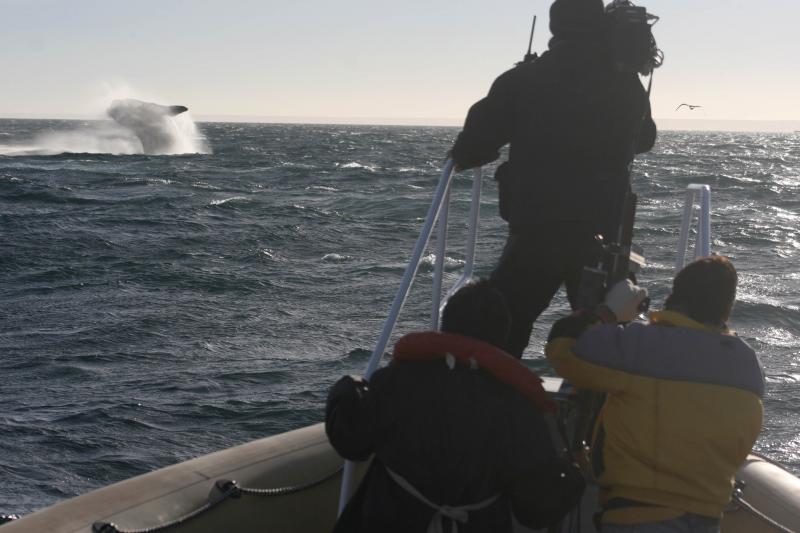
They say that you never forget the first time you see a whale but it wasn’t because I struggled to get out of bed at 6am on Saturday morning that I almost missed out. In the pitch black with my eyes still glued together, part two of this nautical Patagonian adventure got underway, and we are heading north-east to Puerto Pirámides, the only place on the peninsula where you can undertake whale-spotting excursions, according to Rita, our extremely friendly trilingual guide.
I fall back to sleep on the bus instantly, warm and cosy under a blanket and leaning up against a curtained window. Then unbeknown to me, Rita suddenly grabs the microphone and bellows: “Look out of the window to your right and you’ll see the tail of a southern right.” In the scramble to wrench open the curtain, wipe the cloudy window clean and pin my nose to it, the pink-and-orange sunrise dazzles me and my spectacles fall to the floor.
Cursing and scrambling, I finally locate them under the seat in front of me and see a single southern right leisurely surging through the water with the odd gentle prolonged flick of a flipper or tail. A magical moment. “Scientists can’t explain why this particular species of whale offers up its flipper and holds it up in the air for short periods of time,” says Rita, but it also indulges in tail lobbing, flipper slapping and sometimes even head standing, all characteristics that have earned them so many fans around the world.
The peninsula is also home to herds of guanaco, a camelid animal which competes with the hardy sheep for the same food. Bumping up the gravel track in the bus, it is plain to see why this is a Unesco heritage area — it’s pure and unspoilt, a shrub-laden desert where the tufts of grass resemble millions of turned-up rabbits’ tails — and I wonder why it has only been protected for a mere decade. The peninsula and its hardy residents have started to see developments take place in the past few years, such as an almost completed paved road between Puerto Madryn and Puerto Pirámides, a primary school built two and half years ago for the 120-odd pupils in the latter village, and just this weekend to coincide with the opening of the 2009 whale-watching season the local government has bought a US$80,000 bulldozer for the community so that mains water can be installed.
The weather gods are with us once more and wrapped up snug in life jackets, it’s a dry start to the trip as we clatter up a metal ladder from the sandy beach to board a boat with a capacity of 70. A tractor pushes the launch back into the sea, and we’re off, this time searching for the southern right in the Golfo Nuevo.
It was a special weekend given that the end of May signifies the start of the six-month whale-watching season and there were just two launches in the gulf, ours and another press boat complete with divers. Tourists begin to arrive over the coming weeks and the early days are an ideal time to ensure a front row seat: it was hard enough fighting for a space to get a clear view with 22 other people so imagine the elbowing going on when the launch is at capacity.
THE COVER IS BLOWN
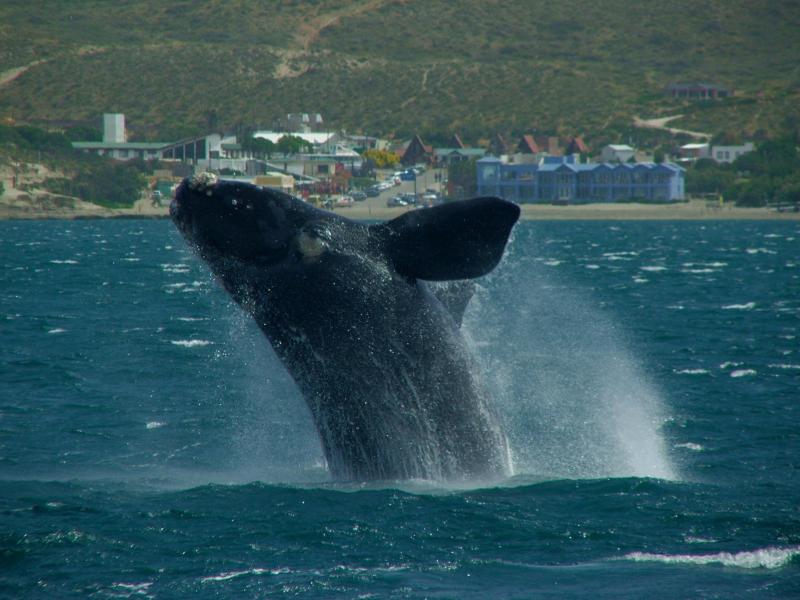
Twin blowholes give away a southern right and her calf. Spurts of water shoot up into the air accompanied by some snorting at around 30 metres away, close enough to see the large patches of white callosities which are thought to help reduce the quantities of parasites the cetacean attracts, but distant enough to be frustrated by the stretch of sea that lies between us.
Possibly the biggest baby in the world measuring five metres at birth, calves are thought to consume around 140 litres of milk a day for a year and remain close to their mother for another two years. Killer whales are their predators — the ferocious orca also migrates to the peninsula to take advantage of the eclectic menu which includes seals and penguins as well as baby southern right whales.
The engine is killed and we bob about in the gulf. Like the Commerson’s dolphins, the whales are inquisitive by nature and slowly make their way closer, and although they are not yet in the comfort zone of freely approaching the launches, they will be within touching distance few months down the line.
The divers make their way into the icy waters — I dipped my hand in from the foot beach before squeezing into my life jacket and believe me, it was icy — and their orange-tipped snorkels facilitate tracking these 70-tonne oceanic giants. They might be huge but that doesn’t make them any easier to spot, with or without spectacles.
I sneak down to the stern and squat in a puddle, just centimetres from the waves. The seemingly white callosities become increasingly visible under the water’s surface and one whale gets within several metres of the boat. It is genuinely exciting to be so close to such a magnificent mammal that has existed for million of years, and its slow, fluid movements mean you get an eyeful and a half of pure blubber. Bottazzi Junior, son of the captain and an English-speaking guide, warns of the inevitable as the female rises and falls, ever nearer to the stern, and me. “When she breathes out, you’re going to get wet.”
Knowledge is everything. As the released water returns to the sea, I catch a rainbow in the air, then catch her backwash straight in my face. What’s a little fluid sharing between friends? And that was the beginning of my friendship with the southern right whale.


